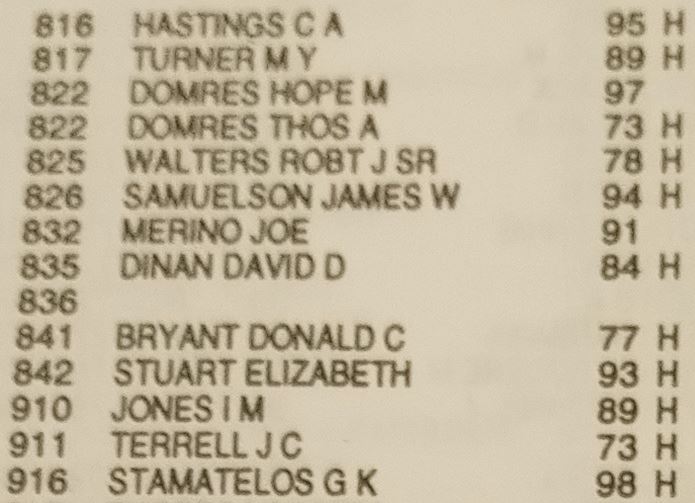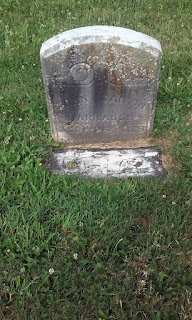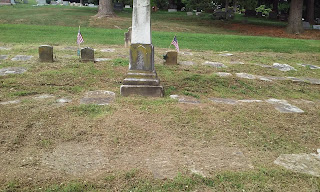Originally published on genealogyatheart.blogspot.com on 14 Sep 2016.
My two most favorite locations to research are the Family History Library in Salt Lake City and the National Archives (NARA) in DC. Actually, NARA is by far the archive that I hold dearest to my heart as it’s the place where I am able to hold in my hands documents that my ancestors held years before. It’s a connection like no other!
It was my final day in the Capitol and as I was headed to the airport in late afternoon, I had with my my suitcase. My sister-in-law had dropped me off at the commuter station close to her home at 9 AM and it was a straight line to the archive.
Took this pic as I came up the steps from the train:

The building isn’t crooked – I was after being on the road for several days!
This view is of the researcher’s entrance – it’s around the side of the building from where the public enter to view the exhibits. Think National Treasure’s entrance.
Going through security was not a problem and the guards pleasantly directed me to the locker room. For a quarter I could get a large locker to place my suitcase and purse. I hadn’t taken off the Kindle’s sleeve so I was sent back to place it with the rest of my belongings. The Kindle and/or a laptop is permissible but cannot have the cases with them. I also took with my my handy dandy plastic Baggie of goodies.
I was prepared and had viewed the Powerpoint presentation at home prior to my trip. The ppt had been updated the week before, however, so I was required to take a few moments to read it. You can check out Researcher Presentation here.
As with the Library of Congress, researchers must obtain a Research Card. You cannot preregister but there was no wait and within minutes I was on my way. The card you receive is free and valid for 1 year. Make sure you have a drivers license or passport with you!
I was directed to a desk where the kind ladies helped me complete the pull request paperwork. Since I had already checked out their holdings I knew exactly what I wanted to get. I highly advise you to do the legwork at home and save time while there. It’s amazing how quickly time flies when you’re into the documents!
The document pull requests must be turned in by the time deadlines or you miss that window. The pull times are 10, 11, 1, 2 and 3. I had already missed the 10 AM – when they open – as I had to get my Research Card. No worries, I was ready for the 11 AM pull. In the meantime, staff directed me to the microfilm room and I was happily viewing Postmaster Records from the late 1800s on several family members.
I was able to save what I found to my thumb drive but you have to put money on your card. A staff member helped me and I decided it was best to use my charge card to guesstimate how much I would spend. I wasn’t sure if the records I was requesting from the pulls were what I wanted and I didn’t want to put more money on the card than needed as I wasn’t planning on being back soon and you can’t get a refund once money is placed. The staff member suggested $5.00 and as it turned out, he was exactly on the money!
By noon I was on another floor asking at the desk if my items had been pulled. They hadn’t yet so I sat at a table and waited.
It was a Thursday midday in July and the place was hopping! Every table in the room was taken. The adjacent room was almost empty but those tables were reserved for Congressmen so the remaining researchers had to share space.
A kind researcher had noticed me downstairs earlier and asked me if I had found everything. I told him that my pull hadn’t come through yet. He suggested that I ask the staff member in another room as he found his request there. Sure enough, there was my goodies!
I’m not going to bore you with the process but this is government so you’ve got to sign and sign again and make sure you’re signing in the right place on the right color paper. Don’t worry – the staff is patient and kind and will help you if you forget what you learned in the ppt.
I had requested 3 pulls and all 3 had information. There are limits – from their website:
“The limit is four original files for each researcher for each pull during a business day up to 24 files in a given day.”
When I come back I plan on bringing my husband to expedite the process.
I sat in awe and read the War of 1812 pension petition of my 3 x’s great grandmother Mary “Polly” Dennis Hodge Adams Elder Search. You read that correctly – she was married four times, outliving 3 of the husbands. Her first husband, John Hodge, went off to the War of 1812 leaving her 8 months pregnant with twins in the wilds of Ohio. She survived the childrens’ births, he did not. I’m descended from her second husband, Edward Adams.
Polly couldn’t write, as evidenced from her X mark. One of her sons and daughters from her marriage to Edward accompanied her and signed the pension request.
I wanted a copy so I went back to the staff member where I had obtained the record and he helped me set up the document on the printer. They use blue paper so as to make sure that no one is walking out with an original. I had put money on the card in the microfilm room so it was quick to make the copies. I signed the document back in and then went through the process with the other two documents, one at a time.
I got teary eyed when I read the Civil War record of my husband’s 2nd great grandfather, Samuel Samuelson, who was the first of our surname. I knew he had sustained an injury but I didn’t know he had become a POW and was traded back to the Union, only to go on and fight another day. Wow.
The last document was another one of my husband’s great grandfathers, John Anderson Long, who had also had a lengthy enlistment in the Union. He had fled Tennessee in the 1830’s as his anti-slavery stance had gotten him in serious trouble. He eventually settled in northern Indiana and that’s where he enlisted when the war began. I hadn’t known he was a teamster. The documents contained his medical history – he had once had pneumonia but recovered.
Unfortunately, it was time to leave as I had a plane to catch. I was directed to the desk where the staff looked through all of the items I had copied and secured them in a locked bag:

All I was allowed to keep out was my locker key and Research Card. I then took these items to the guard desk who cleared me to leave the room. I gathered my belongings and ironically, got a call from my son. He was in the process of getting security clearance for his job and he had called to vent that the security company had not been able to verify his employment from 3 years ago at a local hardware store. I had to laugh – here I was holding documents from the 1840’s through 60’s and there’s no records from 3 years ago locally. I understand how it happened – the store was sold and the new owners didn’t have the old owner’s records. Son had a W-2 but the company wouldn’t take it because they said anyone could make one of those up. I guess they could but I don’t think like that. I suggested he track down the old owner and ask him for verification which he did.
After the phone call I proceeded to the exit, which is the same place as the entrance. The guard opened the bag and returned my items to me. They had locked my suitcase upon entering the building and asked if I wanted it unlocked. It was a carryon and I didn’t need anything in it so I opted to leave the lock on.
I did complete a comment card – I was so impressed with the staff’s professionalism, especially after the lackadaisical attitude of the Library of Congress employees, I had to let the top brass know.
I’m hoping that next summer, I can take the week long class at NARA in July and spend more time. I’m already making a list of who I want to research.
I was sad to end my research trip but thankful that I had the opportunity to do it. I hope that you have gained some tips and tricks next time you are on a GLAM (Gallery, Library, Archive or Museum) quest. The trip took me through public (county and city libraries), private (DAR), and national genealogical repositories (NARA, Library of Congress). Each have their own processes and it’s best to know before you go. Take the time to read online the hours of operation, explore the collection holdings and make notes of what you want to see while you’re there. The findings may leave you with additional questions and a run through a different bread crumb trail than you expected but I assure you, it will be fun and thought provoking. I can’t wait to do it again










